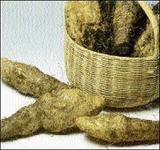
Yams have becom a major non-traditional export crop.
Suddenly, Trelawny yam has vaulted, no bolted, on to the world stage as the food of champions, and in a satire that places it on a list of 'banned substances' that give an edge to athletes.
World and Olympic champion and three-time gold medallist in Beijing, Usain Bolt, was raised in the parish famous, at least in Jamaica, for its yam.
His mother, Jennifer Bolt, told the world that after his famous 9.69 seconds run in the 100 metres, her son was raised on the tuber.
Yam, over the years, has grown in stature domestically as a favoured accompaniment to Jamaican breakfast and dinner dishes.
Entrepreneurial promise
Trelawny has also seen entrepreneurial promise in the tuber and its annual yam festival - which has become a calendar event - which continues to showcase new and innovative dishes and uses.
But the 'ground provision', as rural Jamaicans define or categorise such foods, has not, in the economic sense, been a top performer.
Indeed, yam as an export crop, has been waning over the years, after farmers decided that they were being exploited by middlemen who marketed the crop.
Additionally, after two decades of pushing for cultural change, agriculture officials gave up on mini-sett yam in the 1990s - a new technology that was meant to produce yams in a form more suitable for export and in line with demands by overseas buyers.
The farmers simply rejected attempts to change their farming practices.
The staple, which comes in many different varieties - Lucea, negro, Renta, St Vincent, sweet, Tau, yellow, and others - is said to be valued at about $72.9 million per annum for the parish, according to the Trelawny branch of the Jamaica Agricultural Society (JAS).
But Trelawny is not the only parish where yam is grown.
Its performance has been erratic over the years.
Output peaked
According to the Statistical Institute of Jamaica (STATIN) data, yam production hit 113,124 metric tonnes in 2007, its second-lowest point in the past two decades, during which output peaked at 253,371 tonnes.
The lowest point was in 2005 - post-Hurricane Ivan - when production dropped to 107,294 tonnes.
The 2007 outturn was an eight-point drop on the previous year.
Said Trelawny custos and businessman Roylan Barrett: "There is great need to improve productivity using modern technology."
He also sees business and revenue potential in the product.
Barrett is among a group leading a project to process and package yam as a convenience product befitting a modern lifestyle.
The custos said of the project only that the group was looking at how to present the staple to consumers in a powdered form that would preserve its life over a longer period.
Senator Norman Grant, president of the JAS - a national lobby for farmers with a network of branches islandwide - also tells Sunday Business that the tuber, notwithstanding that fewer tonnes are being reaped domestically, is not dead.
"... The demand for the product internationally has grown, in particular, among the Jamaican community overseas," he said.
Yam exports
According to Statin, the value of yam exported for the first four months of 2008 totalled US$10.95 million, a performance that if maintained, would eclipse the past two years.
The value of exports in 2007 was US$15.5 million, while exported yam fetched US$14.7 million in 2006.
While Grant could not say whether the tuber could reclaim glory in volume production, he advised Sunday Business that the JAS was engaged in a project with farmers in Trelawny to set up a JAS yam farmers' cooperative.
The new group will be marketing the Trelawny yam internationally, and plans to brand it as the 'best in the world.'
"Properly packaged, the Jamaica yam market can benefit significantly from the record-breaking run of Usain Bolt," he said.
At present, the staple forms a large part of the Jamaican's daily diet. Indeed, Statin data suggest that it is consumed more by men than women.
Yam is classified under the food group of starchy roots and tubers. That grouping of food records mean annual consumption per capita of $2,624 for males as the head of households, and $2,188 for females.
This represents approximately 5.6 per cent of the average household consumption for males, and 5.5 per cent for females.
The staple has produced a variety of spin-off products, including the latest, yam wine, a product from the kitchens of the Cockpit Country.
Others include sauces, liqueurs, seasonings and baked products, including cakes and pudding.
Revenue
While the by-products are not commercialised on a large scale, at least one producer says she generates revenue of $40,000 to $50,000 from her weekend sales and at shows such as the Trelawny Yam Festival, where the products are showcased.
The Trelawny Yam Festival is an event that is held annually to celebrate the culture and heritage of Trelawny and the Cockpit Country in which the cultivation of yam is an integral part.
Two of the yam by-products - sauce and liqueur made by the Trelawny 4-H Club - are also currently at the Scientific Research Council undergoing testing for possible large-scale production.
sabrina.gordon@gleanerjm.com

